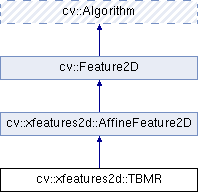|
| virtual float | getMaxAreaRelative () const =0 |
| |
| virtual int | getMinArea () const =0 |
| |
| virtual int | getNScales () const =0 |
| |
| virtual float | getScaleFactor () const =0 |
| |
| virtual void | setMaxAreaRelative (float maxArea)=0 |
| |
| virtual void | setMinArea (int minArea)=0 |
| |
| virtual void | setNScales (int n_scales)=0 |
| |
| virtual void | setScaleFactor (float scale_factor)=0 |
| |
| virtual void | detect (InputArray image, std::vector< Elliptic_KeyPoint > &keypoints, InputArray mask=noArray())=0 |
| | Detects keypoints in the image using the wrapped detector and performs affine adaptation to augment them with their elliptic regions. More...
|
| |
| virtual void | detectAndCompute (InputArray image, InputArray mask, std::vector< Elliptic_KeyPoint > &keypoints, OutputArray descriptors, bool useProvidedKeypoints=false)=0 |
| | Detects keypoints and computes descriptors for their surrounding regions, after warping them into circles. More...
|
| |
| virtual | ~Feature2D () |
| |
| virtual void | compute (InputArray image, std::vector< KeyPoint > &keypoints, OutputArray descriptors) |
| | Computes the descriptors for a set of keypoints detected in an image (first variant) or image set (second variant). More...
|
| |
| virtual void | compute (InputArrayOfArrays images, std::vector< std::vector< KeyPoint > > &keypoints, OutputArrayOfArrays descriptors) |
| |
| virtual int | defaultNorm () const |
| |
| virtual int | descriptorSize () const |
| |
| virtual int | descriptorType () const |
| |
| virtual void | detect (InputArray image, std::vector< KeyPoint > &keypoints, InputArray mask=noArray()) |
| | Detects keypoints in an image (first variant) or image set (second variant). More...
|
| |
| virtual void | detect (InputArrayOfArrays images, std::vector< std::vector< KeyPoint > > &keypoints, InputArrayOfArrays masks=noArray()) |
| |
| virtual void | detectAndCompute (InputArray image, InputArray mask, std::vector< KeyPoint > &keypoints, OutputArray descriptors, bool useProvidedKeypoints=false) |
| |
| virtual bool | empty () const CV_OVERRIDE |
| | Return true if detector object is empty. More...
|
| |
| virtual String | getDefaultName () const CV_OVERRIDE |
| |
| void | read (const String &fileName) |
| |
| virtual void | read (const FileNode &) CV_OVERRIDE |
| | Reads algorithm parameters from a file storage. More...
|
| |
| void | write (const String &fileName) const |
| |
| virtual void | write (FileStorage &) const CV_OVERRIDE |
| | Stores algorithm parameters in a file storage. More...
|
| |
| void | write (FileStorage &fs, const String &name) const |
| |
| void | write (const Ptr< FileStorage > &fs, const String &name) const |
| |
| | Algorithm () |
| |
| virtual | ~Algorithm () |
| |
| virtual void | clear () |
| | Clears the algorithm state. More...
|
| |
| virtual void | save (const String &filename) const |
| |
| void | write (FileStorage &fs, const String &name) const |
| |
| void | write (const Ptr< FileStorage > &fs, const String &name=String()) const |
| |
Class implementing the Tree Based Morse Regions (TBMR) as described in [287] extended with scaled extraction ability.
- Parameters
-
| min_area | prune areas smaller than minArea |
| max_area_relative | prune areas bigger than maxArea = max_area_relative * input_image_size |
| scale_factor | scale factor for scaled extraction. |
| n_scales | number of applications of the scale factor (octaves). |
- Note
- This algorithm is based on Component Tree (Min/Max) as well as MSER but uses a Morse-theory approach to extract features.
Features are ellipses (similar to MSER, however a MSER feature can never be a TBMR feature and vice versa).



 Public Member Functions inherited from cv::xfeatures2d::AffineFeature2D
Public Member Functions inherited from cv::xfeatures2d::AffineFeature2D Public Member Functions inherited from cv::Feature2D
Public Member Functions inherited from cv::Feature2D Public Member Functions inherited from cv::Algorithm
Public Member Functions inherited from cv::Algorithm Static Public Member Functions inherited from cv::xfeatures2d::AffineFeature2D
Static Public Member Functions inherited from cv::xfeatures2d::AffineFeature2D Static Public Member Functions inherited from cv::Algorithm
Static Public Member Functions inherited from cv::Algorithm Protected Member Functions inherited from cv::Algorithm
Protected Member Functions inherited from cv::Algorithm 1.8.13
1.8.13